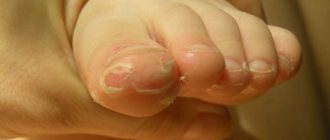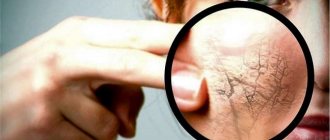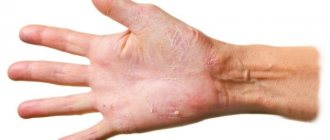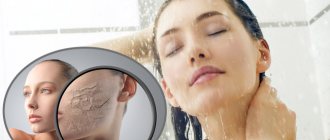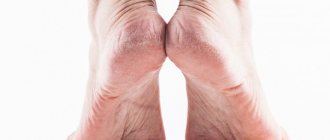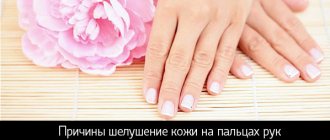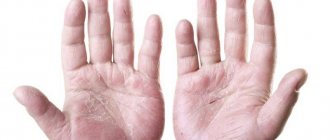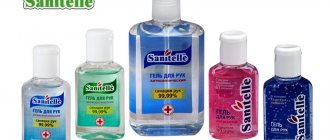A person is constantly in motion, whether it be walking, sitting or doing physical exercise. Constant foot activity leads to dry skin on the feet. Often in copious amounts.
It happens that this process causes pain and cracks. Many people experience peeling skin on their legs. This brings discomfort. But few people know why the skin on the feet peels.
As soon as the skin begins to peel, you want to take a rich cream and lubricate your feet and the skin between your toes. Before lubricating your feet with cream, you need to find out the causes of this disease.
Peeling skin on the legs: normal or pathological?
Not a single highly qualified doctor can accurately and immediately answer the question of why peeling appears on the feet. A number of factors can provoke this disorder, from harmless to life-threatening. In some patients, poor skin condition on the toes is a consequence of chronic vitamin deficiency, in others it is an advanced fungal infection. Accordingly, treatment regimens will have fundamental differences. In any case, if the skin between the toes peels, we are talking about a certain disorder in the body or the adverse effects of external factors. Cracking of the epidermis on the legs is not normal.
Disease prevention
Problems with flaky skin can be easily avoided with proper care. Regular moisturizing and cleansing of the feet with a pumice stone or a special brush should become the norm for a person who cares about their health. Feet should always be washed with warm water and rinsed with cool water. After such water procedures, the limbs must be wiped dry, then apply a high-quality moisturizer to the toes and heels. If, in addition to peeling between the fingers, cracks appear, it is necessary to treat them with a special ointment or hydrogen peroxide.
If the skin on your toes and feet is peeling, it is important to choose the right shoes. In order not to aggravate the situation, women are not advised to wear high-heeled shoes and sandals that are too open. If you have to spend most of the day on your feet, it is advisable to lie down for a while in the evening with your legs raised - this way you can improve cell nutrition and blood supply.
You can also periodically take foot baths with the addition of decoctions of calendula, chamomile flowers or nettles. Many people like to use sea salt. It is desirable that the temperature of the prepared solution be 38-40 degrees. The procedure itself should last at least 20 minutes. Every person should understand that it is easier to prevent a disease than to treat it afterwards.
Failure to comply with hygiene rules
Improper care of the skin of the feet is the first thing to rule out if the skin between the toes is peeling. The reason, at first glance, is insignificant, but often it is precisely this that leads to serious consequences. With insufficient foot hygiene, the risk of fungal infection and bacterial infection increases, which will be indicated by an unpleasant odor, change in color and texture of the nail plates.
In addition to poor foot skin care, other factors can also cause the problem. You can determine why the skin on your toes is peeling by the type of shoes a person wears. Small size, due to which the shoes constantly rub, poor quality material - it is likely that this is the whole solution to the problem.
Causes of peeling
For some reason, every person takes care of their face and takes care of it, but not their feet, and almost no one knows why the skin on their feet dries and peels. But in addition to the fact that such a defect looks unpleasant visually, it also causes a lot of discomfort in the form of scratching and tightening.
In order to quickly get rid of a sudden problem on the skin, it is necessary to find out the factor that provoked such an illness. There are four main groups, which include:
- negative external influence;
- unhealthy diet and allergies;
- age reasons;
- infectious lesions of the extremities.
Negative external influence
The skin on your heels and feet can become dry due to many factors. The main irritants are:
- The air in the apartment is too dry, especially in winter when the heating is on.
- Underwear, tights, socks made from artificial fabric, especially if there is a tightening effect. Such materials do not allow the skin to breathe normally, causing water imbalance.
- Ultraviolet rays can be very dehydrating, especially if people overuse tanning beds.
- Water with a high chlorine content, such as in a swimming pool, can also be quite drying to the skin.
https://youtube.com/watch?v=aE2zHczuRwk
Age-related thinning of the skin
The skin is designed in such a way that with age it begins to change, becomes thinner, loses much more moisture - all this leads to peeling. This is directly related to the disappearance of collagen fibers. Namely, they are engaged in the formation of the mass of the skin.
In turn, the water-lipid mantle simply ceases to cope with the load due to a decrease in the fluid that enters the skin, and this is also affected by disturbances in the secretion of sebum. These age-related changes become the reasons why the skin on the legs peels.
https://youtube.com/watch?v=hKIJbl_tTZw
Infectious and somatic diseases
As soon as a person develops any dermatological disease, the disease is immediately followed by a violation of the skin barrier. This is followed by loss of moisture, which is why the skin becomes dry, which leads to peeling. If the skin between your toes is peeling and itching or even cracking, it is most likely a fungal infection. In this case, only a dermatologist will help get rid of the problem, who, based on laboratory tests, will prescribe the appropriate treatment.
And also one of the reasons why the skin on the feet, calves and legs peels off can be diseases such as eczema, psoriasis and exfoliative dermatitis. In children, flaking and itching of the lower extremities can be caused by Kawasaki Syndrome. Self-treatment cannot be carried out, but to establish an accurate diagnosis it is better to consult a doctor.
https://youtube.com/watch?v=IBHGEPq-YGI
In addition to dermatological diseases that cause dry skin on the legs, there are a number of somatic ailments:
- cirrhosis of the liver;
- hepatitis;
- kidney diseases;
- diabetes.
It should be added that quite often such problems on the legs occur due to the use of steroid hormonal drugs, and even short-term use of such drugs causes dysfunction of the horny skin.
Unbalanced diet
One of the main factors why women's heels peel is pregnancy. This is due to hormonal imbalances, which cause the skin to peel and peel, and this can be quite painful.
People who have changes in their skin in the form of peeling should adjust their diet. Be sure to include vegetable oils, dishes with lots of vegetables, fresh fruits, fish dishes and seafood. With a lack of vitamins or vitamin deficiency, problems associated with peeling on the feet and fingers may also appear.
An allergic reaction is one of the main causes of skin irritation and, as a consequence, peeling. Moreover, irritants can be cosmetics, food consumed, synthetic clothing and much more.
Weakening of the immune system
The problem of peeling of the epidermis on the extremities is most often encountered by those with dry skin. The top layer of skin on the fingers can also crack due to an acute lack of vitamins and minerals in the body, or prolonged exposure to unfavorable environmental conditions. This also includes a sudden change in temperature and climate: the skin simply does not have time to adapt to new conditions.
Another reason why the skin on the toes peels is swimming in too hard, chlorinated water, which kills local immunity. The protective mechanisms of skin cells weaken, so the elasticity and integrity of tissues is impaired. By the way, for the same reason the epidermis on the legs may peel off. This skin change is observed in people of different ages.
Treatment methods
It is better to solve any problem at the initial stage. At the first signs of cracks, you need to consult a dermatologist, who will make an accurate diagnosis and prescribe step-by-step treatment:
- Establishing and eliminating the cause of occurrence.
- Reducing the mechanical impact on the problem area (recommends wearing soft and comfortable shoes made of high-quality materials that prevent the appearance of diaper rash).
- For fungal infections, the dermatologist prescribes medications (Exoderil, Miconazole), which have a comprehensive effect on the source of inflammation and eliminate the accompanying symptoms.
- In the presence of purulent inflammation, therapy with antibiotics is carried out.
- Application of healing ointments based on Panthenol, Solcoseryl gel or Shostakovsky balm.
- Use of protective patches, arch supports.
- Maintain hygiene with antibacterial agents, you need to wipe your feet dry with blotting movements and apply moisturizers.
- For deep cracks, hardware treatment may be required.
- A balanced diet is prescribed to compensate for the lack of vitamins.
Medicines have contraindications; before use during pregnancy, you should consult a specialist.
An X-ray will not help identify the cause of the crack; it is pointless to do it.
For diabetics, the treatment regimen differs from the traditional one in that it is strictly forbidden to keep your feet in hot water. Only warm water with the addition of SixtuMed oil, which has an antimicrobial effect. The resulting solution will carefully cleanse the skin of impurities and improve access to the therapeutic effects of a balm of the same brand, aimed at eliminating fungus, moisturizing and healing.
For the delicate and sensitive skin of a child, the resulting cracks can cause severe pain; you need to take timely measures and lubricate the damaged area with Panthenol-based preparations (Bepanten, Dexpanthenol), which accelerate the regeneration process and alleviate the condition.
Fungus on the foot
This is the most common disease of infectious origin. In addition to peeling of the epidermis, foot fungus causes itching, burning, redness and a foul odor. This contagious disease most often affects people with weakened immune systems, young children, the elderly, pregnant women, and those who do not observe basic hygiene rules in public areas (swimming pools, saunas, baths, etc.).
Foot fungus can be recognized by the appearance of severe unbearable itching and redness. If the necessary therapeutic measures are not taken in time, after a few days it will become noticeable that the skin between the toes is peeling. For treatment, antimycotic drugs of systemic and local action are prescribed.
Causes, treatment
Causes: lack of hydration, poor cosmetics, sun exposure, dry air, allergies, skin diseases, antibacterial soap, vitamin deficiency, dehydration, weakened immune system. If you constantly use household chemicals without gloves, stop.
The reason may be earthworks. If your skin itches, turns red, or breaks out in rashes, consult a doctor. Drink more water, moisturize your hands with cream, take vitamins. Do not wash your hands with very hot water. Gels and ointments: bepanten, elokom, fenistil. For fungus, Nizoral, Exoderil, Diflucan are prescribed.
Before you buy hand cream, check the composition. It should contain collagen, glycerin, hyaluronic acid, linoleic acid. The beauty salon will offer you a hot manicure and paraffin therapy. The procedures are inexpensive and give quick results. Read more about the causes and treatment below.
Eczema and psoriasis
These are completely different dermatological pathologies, but they have one thing in common: the inability to establish the cause of the development of the pathological process. Both eczema and psoriasis can affect different parts of the body, but eczema is most often diagnosed on the toes. Skin diseases of this type occur against a background of stress, exhaustion of the body, an allergic reaction and a number of other unfavorable factors.
With eczema, specific red blisters appear on the skin, which after a while burst and become very flaky and itchy. Psoriasis, unlike eczema, manifests itself on tissues as specific scales. It is better not to delay the treatment of this disease, as it can affect the epidermis not only on the toes, but throughout the body, and even affect the joints. In severe cases, psoriasis leads to a significant decrease in the patient's quality of life.
What will help against peeling skin
Flaky spots on the big toe must be eliminated using special creams and ointments. If cracks and wounds appear, treat the surface with the antiseptic Chlorhexine or Miramistin. However, dermatologists recommend first identifying the cause of the changes, taking vitamins (Retinol, Imudol, Vitamin E) and lactobacilli, and improving hygiene.
If this problem occurs in a child, it is not recommended to self-medicate. Many drugs are contraindicated in childhood. To exclude atopic dermatitis, before going to the dermatologist, adjust your diet and change your washing powder.
Pharmacy products
When the skin on the leg breaks, which is accompanied by severe peeling, itching and pain, it is necessary to urgently begin medical treatment. If the cause of symptoms is an allergy, antihistamines (Zodak, Suprastin, Fenistil gel) are taken. You should also definitely stop contacting the intolerant substance.
You can eliminate excessive dryness or eczema using the following medications:
- "Advantan";
- "Salicylic ointment";
- "Prednisolone";
- "Lokoid";
- "Triderm";
- "Methotrexate."
If a dermatologist detects the development of a fungus in a scraping or during an examination, treatment is prescribed for 2 weeks to 3 months with medications:
- "Exoderil"
- "Mikoderil";
- "Lamisil";
- "Clotrimazole";
- "Mikospor";
- "Oflomil";
- "Orungal."
For quick results, it is necessary to use drugs that enhance immunity and topical agents. Dry skin is deeply moisturized daily using Bepanten, Radevit, and D-panthenol. These ointments promote wound healing, accelerate regeneration processes, and have no contraindications.
If a scaly spot appears not only on the thumb, but throughout the body, a dermatologist will diagnose psoriasis. This disease is chronic and cannot be cured. But with proper care during an exacerbation, you can significantly reduce discomfort and prevent the spread of white plaques.
Home Recipes
Traditional recipes are an effective remedy for eliminating peeling. Herbal decoctions and infusions do not cause complications and have a general strengthening effect. It is recommended to use vegetable and essential oils, make soft scrubs from food, and you can also take baths periodically.
The best recipes for eliminating dry and flaky feet:
- Nourishing cream for restoration and disinfection. Ingredients: 2 tbsp. spoons of sour cream, 1 teaspoon of olive oil, 5 drops of tea tree oil. Mix all ingredients and apply in a thin layer. For dry, cracked dermis, you don’t need to add sour cream.
- Scrub for cleansing the skin of keratinized epithelium. Ingredients: 50 g oatmeal or oat flour, 1 teaspoon each of salt and soda. Grind the flakes in a blender or coffee grinder, add the remaining ingredients. Rub the dry mixture into wet feet and between the toes.
- Skin softening bath. Ingredients: 2 teaspoons sea salt, 2 tbsp. spoons of soda, 20 ml of liquid soap. Mix the ingredients and add to hot water. Steam your legs for 20-30 minutes, then use a penza.
- Intensive hydration and cleansing from germs. Ingredients: 50 ml olive oil, 1 egg yolk. Beat the yolk with a blender, add heated oil to it. Lubricate the fingers and between the fingers with the resulting mixture, wrap them in a plastic bag or cling film, and put socks on top. After half an hour, wash off.
Also, if your feet sweat excessively, it is recommended to wash them with chamomile or oak infusion. To kill the infection and prevent the spread of fungus, use laundry soap. Just grind it on a grater and rub it into your skin overnight.
What do experts recommend?
The main reason for the appearance of loose, flaky dermis is a fungal infection. This disease is difficult to treat and easily transmitted. Therefore, dermatologists recommend adhering to the following rules:
- do not wear someone else's shoes;
- To care for your skin and toes, give yourself individual pedicure tools;
- clean the bathtub regularly with cleaning products;
- do not use disinfectant soap too often (it washes away not only germs, but also the protective layer of the dermis);
- socks are changed daily;
- visit a pedicurist every 3-4 weeks, make sure the instruments are sterile;
- After recovery, wash all bedding and treat the inside of your shoes with disinfectants.
Important! Stress can trigger dry skin. Therefore, during treatment it is recommended not to be nervous, relax more, and walk in the fresh air.
When eczema is detected, comprehensive treatment is prescribed. When your toes are actively itching and peeling, the skin needs to be intensively moisturized and nourished, and avoid alkaline soap and sweat removers. The dermatologist will prescribe a special diet, free of allergens, smoked foods, spicy and sweet foods.
Allergy
At first glance it may seem like the most harmless reason. The skin on the toes peels off if this area of the limb is exposed to a certain irritant - a detergent or cosmetic, low-quality synthetic material from shoes, socks, etc.
Sometimes allergies manifest themselves not only by damage to the epidermis, but also by attacks of suffocation, lacrimation, sneezing, and swelling of the mucous membranes. If the skin on your toes is peeling, you need to consult an allergist. Knowing about your allergic predisposition, it is necessary to take antihistamines in a timely manner and avoid contact with the irritant.
Causes of cracks
Cracks in the fingers and feet can occur as a result of:
- Wearing inappropriate shoes (tight or wide shoes made of materials that do not allow the skin to breathe, which provokes microcirculation disorders).
- Fungus (a common occurrence when the rules for visiting public baths and swimming pools are not followed).
- Atherosclerosis (skin becomes thinner and damaged due to blood stagnation).
- Patients with diabetes suffer from dry, cracked skin on their feet.
- Poor nutrition, vitamin deficiency.
- Neglect of hygiene and hydration.
- Mechanical damage (skin becomes rough from walking barefoot, unprofessional pedicure).
Is it possible to get rid of peeling
As soon as the causes of deterioration of the skin on the toes become known, it is first necessary to direct efforts to eliminate them, and only after that focus on combating the cosmetic defect. You can restore the condition of the skin using a set of procedures:
- baths with table or sea salt, essential oil;
- using an exfoliating scrub or special pumice;
- using moisturizing and nourishing creams for the skin of the feet.
If the skin of the toes peels and cracks due to serious dermatological pathology, long-term treatment with special drugs cannot be avoided. Thus, for dermatitis and eczema, the use of steroidal anti-inflammatory and regenerating ointments (Elocom, Afloderm, Celestoderm) is often required, and for allergies, antihistamines (Loratadine, Claritin, Cetrin, Zodak) ). If a bacterial infection attaches to the affected areas, the patient is prescribed local antiseptics (Chlorhexidine, Miramistin).
Treatment with folk remedies
Milk foot baths
There are a large number of treatment methods from folk remedies. For example, foot baths. Add table or wine vinegar to the water. Place your feet in this container. After the procedure, your feet should be thoroughly dried. Use only disposable towels; if you don’t have any, you can boil a regular towel and socks. Boiling will kill the fungus. Next, soak the socks in the vinegar solution and leave overnight.
Vinegar can also be diluted with salt and water, or salt with water and soda. Saturated salt solutions should not be hot, but not cold either. Baths are made from plants:
- Lilac flowers are poured with vodka. They insist for two weeks. You can make lotions from this solution.
- Celandine herb has a beneficial effect on the results of treatment of all skin diseases.
- The mint herb is ground with salt and this paste is applied to the affected areas.
- Rowan leaves are also ground with salt.
Garlic also kills fungus.
Dilute the garlic pulp with butter and apply to the wound surface. Salicylic ointment is a remedy available to everyone. For quick results, it is better to use 35% ointment. This strong ointment solution can burn healthy skin. But it removes all sores and keratinized tissue on the feet. You can buy foot cream or make it yourself. You will need: calendula ointment – 20 grams, vitamin A. Mix everything and spread on the feet. After taking a bath, thoroughly lubricate your feet and put on cotton socks and leave them overnight. And we do this every day until we get the desired result.
In tandem, baths and moisturizer work much better. Feet become smooth and well-groomed.
How to cure foot fungus
To get rid of a skin infection, you will have to be patient and calm. The pathology occurs in both adults and children. Many people have been forced to fight foot fungus for years by applying antifungal drugs to the skin. With the slightest weakening of the immune system, the disease can recur.
To confirm the diagnosis, the patient is sent for a scraping. Laboratory testing is carried out to determine the type of pathogen and its sensitivity to the antifungal component. Treatment of infection requires the use of external (liquid solutions, emulsions, ointments, creams) and systemic drugs. To prevent fungus, the medicine is also applied to the nail plates. If today the skin peels off on the big toe, then tomorrow, with a high degree of probability, it will peel off on other parts of the foot.
What not to do for cracked fingers
- You cannot continue to walk in tight, uncomfortable shoes, this can aggravate the situation - dry skin will peel and continue to crack. The treatment will not bring the desired result.
- Neglect hygiene. Cleanliness is the key to health. At the end of the day, be sure to take a warm foot bath and apply a healing ointment.
- It is not recommended to use hardware treatment at home and if there are pustules, you can introduce an infection into the blood.
- Treat at home if dry, cracking feet are caused by serious chronic diseases.
- Visit public baths, saunas, swimming pools until complete recovery.
Ignoring the problem can cause serious harm to health; it is necessary to urgently respond to any changes in the body in order to prevent negative consequences, including damage to the joints.
Treatment is carried out quickly and efficiently only in the early stages; it is even better to exclude the occurrence of a problem. Prevention consists of daily limb care. Evening treatments using a scrub and nourishing cream will help keep your feet smooth.
The article has been verified by the editors
Why does toe fungus become chronic?
The main reason for the failure of patients who are trying to get rid of the disease is the use of medications in the absence of treating shoes with antifungal agents. The situation looks like this: as soon as the patient manages to remove the fungus from the skin or suppress its activity, re-infection occurs. Therefore, the best solution when treating an infection is to replace your shoes with new ones.
Household members who live with a person infected with a fungal infection must take precautions to avoid becoming infected. First of all, you should not use the patient’s personal belongings, shoes, including house slippers. It is advisable for the patient who has fungus on his toes to walk on the floor not barefoot, but to wear socks. For prevention purposes, family members of the patient should use antifungal sprays. Such drugs should be prescribed by a dermatologist.
Treatment and prevention
Treating the foot with anti-fungal ointment
Foot skin treatment is simple but long lasting. On the first day, it is advisable to start using steroid hormones. If the situation is not severe, you can buy antifungal ointment or cream. The drug of group B includes two active ingredients: one destroys the fungus, the second relieves itching and inflammation of the skin. Even when the illness has passed, you still need to apply it for another two weeks or even a month. Systemic therapy can be used, but it has a number of limitations.
Shoe care is the most important. It must be washed at a temperature of at least 60 degrees to kill all fungal spores. Boil and steam insoles to get rid of fungus in slippers and boots forever. Bleach also helps a lot when washing. At the end of treatment, after a month, it is advisable to throw out shoes and socks and buy new ones. It is worth remembering that fungus is a recurrent thing.
Before visiting baths, saunas and other similar places, it is recommended to spray Lamisil spray on your feet and between your toes. This will help prevent skin fungus. Use rubber flip-flops in bathhouses and public bathing areas.
What to do if the skin on your child’s toes is peeling?
One of the reasons why the epidermis on the legs peels off at an early age is hyperhidrosis. This pathological condition is characterized by increased sweating of the feet. Hyperhidrosis often develops due to the baby wearing shoes or clothing made from synthetic materials. If a child's foot is in shoes for a long time, it begins to swell, as a result of which the surface layer of the skin suffers. If the baby has such a problem, before putting on boots or sandals, the foot must be treated with a special talcum powder or cream.
Peeling skin on the toes of children is often a sign of dysbiosis, a condition characterized by a deficiency of beneficial bacteria in the gastrointestinal tract. Dysbacteriosis often occurs while taking antibacterial drugs. Skin problems in a child go away on their own as soon as normal microflora in the intestines is restored. As therapy, the child is prescribed probiotics that help “populate” the missing bifidobacteria and lactobacilli.
The skin between your toes peels off. Why does the skin between my toes peel?
Deterioration of the skin condition in the interdigital area can be caused by non-compliance with personal hygiene rules, vitamin deficiency, taking certain medications, and excess weight. But often such a sign indicates a malfunction of organs and systems, the presence of infectious and endocrine diseases.
Why peeling occurs:
- Diabetes mellitus - small and then large bleeding cracks appear on the pads of the fingers and between them.
- Shingles - severely peeling, peeling off the skin in the interdigital space.
- Eczema is accompanied by different types of rashes - blisters, scales, erosions, rashes. As the disease develops, itching, severe redness, inflammation occurs, and the capillaries become more noticeable.
- Allergies to medications, food, hygiene products, and cosmetics can manifest themselves in the form of itching, peeling, redness, and dense crusts between the toes.
- Skin dermatitis - inflammatory processes provoke the appearance of excessive dryness of the skin, it begins to crack, swell, peel off, and itches very much.
- Hyperhidrosis of the feet - increased sweating provokes the active growth of pathogenic microflora, inflammation occurs, the skin cracks and peels off.
Shoes and socks made of synthetic materials almost always cause the appearance of flaky areas - the skin cannot breathe normally, becomes wet, and begins to rot, which negatively affects the condition of the epidermis.
Fungal skin lesions
Fungal infections are one of the main causes of wounds and peeling and detachment of the skin in the interdigital space. With mycoses, an unpleasant odor of the feet, burning, itching, and pain appear. The disease is accompanied by a deterioration in the condition of one or more nails - the plate becomes cloudy, its color, thickness and structure change, all these symptoms are clearly visible in the photo.
Types and fungal infections:
- Athlete's foot - cracks appear on the heels and between the toes, the skin is very itchy and flaky, redness and a characteristic unpleasant odor appear. Infection occurs in public places.
- Rubromycosis - the disease manifests itself in the form of burning, weeping ulcers, itching in the interdigital area. As the pathology develops, the skin begins to peel off and the wounds bleed.
- Candidiasis. Sometimes yeast fungi settle on the skin of the feet - the epidermis begins to dry out very much, peel off, and wounds appear between the toes.
How to prevent peeling skin on your toes
First of all, you should stop wearing tight and uncomfortable shoes. Shoes should be soft and light, not rubbing your feet. You should also pay attention to increased sweating of the feet, which can lead to unpleasant consequences. A humid environment is most comfortable for the proliferation of pathogenic microorganisms and the development of fungal infections.
Each of us can independently strengthen the body and increase its resistance to various infections by making appropriate adjustments to our lifestyle:
- eat a balanced diet;
- minimize the consumption of salty, spicy, fatty foods;
- give up alcoholic beverages;
- if you are prone to allergies, use allergenic foods with caution (nuts, seafood, citrus fruits, chocolate, honey, strawberries, etc.);
- avoid areas where there is a period of mass flowering of plants;
- have a full rest.
To prevent the development of skin diseases, it is necessary to constantly take measures to strengthen the immune system. Immunomodulators and other medications can be used only after consulting an immunologist.
If the epidermis on the legs is peeling due to increased dryness, it is important to constantly moisturize it with the help of medicinal and cosmetic products. A worthy alternative to pharmaceutical and store-bought formulations is vegetable oil or full-fat sour cream.
Foot care
Socks for pedicure
You need to constantly take care of your feet, giving them a little attention every day. To do this, it is enough to have a pumice stone and a synthetic brush. It is better to exclude all metal devices for foot care, as they injure our feet.
Today, decorative cosmetics stores sell special pedicure socks. They are used in an innovative procedure that allows you to get your legs in perfect order at home without the risk and waste of time visiting an expensive beauty salon. The main components included in the composition are lactic acid and plant extracts of burdock, lemon, ivy, sage and other medicinal herbs. They stimulate the process of rejection of dead cells naturally.
Experts recommend using a personal washcloth and doing oatmeal peels. You can do self-massage of the entire foot, up to the thigh. After using foot baths, it is advisable to use special socks.
Traditional methods
An excellent weapon against diaper rash between the fingers is warm baths with decoctions and infusions of medicinal plants. Calendula, chamomile, tansy, plantain in any combination will help with inflammation and heal microcracks.
In addition to all this, these natural healers have excellent deodorizing qualities. To make your limbs sweat less, you need to constantly take foot and hand baths with a decoction of oak bark. Some patients do similar procedures with a decoction of lemon peels.
Tannins normalize and narrow the pores through which sweating occurs. Warm water coupled with medicinal plants heals diaper rash and restores the nervous system.
Another proven remedy is soap containing tar. It is used quite widely in alternative medicine, in particular for the treatment of most dermatological pathologies. From now on, it is not necessary to use tar in its pure form.
Industrial goods stores sell classic bar soap, cream soap, and liquid soap. This simple remedy will dry and disinfect your feet, and also moderate irritation. Starch, a natural product, is used topically to eliminate unhealthy sweating.
This procedure can be done at home. Advanced stages of mycotic irritations are treated with lotions with sulfate components, as well as copper and zinc substances. Healing balms and gels are used at the end of foot baths.
Complete the procedure with tar in the form of a paste, suitable ointment, and oil. One of the newest techniques is to disinfect the affected areas with water with salicylic acid, levomekol, plus powder with talcum powder.
If the above methods do not bring success, then it is better to trust yourself to a dermatologist. Each patient will be prescribed individual treatment.
Fungus treatment
To cure mycosis, proper and timely examination is required. Therefore, it is not recommended to postpone a visit to a specialist.
The reason is the similarity of symptoms of different types of fungi. It may happen that the patient will use an ointment, the use of which is not appropriate for this pathology.
Fortunately, modern pharmacy offers ointments and sprays for a wide range of fungi caused by various pathogens. The main threat is the following: the patient stops treatment at the first sign of recovery.
Have willpower, and be sure to complete the antifungal course. Otherwise, the fungus will take hold and it will be difficult to get rid of it.
Not only does the skin on your feet become extremely itchy, but the resulting diaper rash becomes wet and emits a foul odor. It’s not surprising that you feel the urge to climb up to the ceiling just to make the burning between your fingers stop. If the disease is advanced, the dermatologist will prescribe medications for oral administration.
At the same time, the skin is treated with ointments.
Symptoms
Pathologies of the nail plates and dermis combine each other in almost every third.
Signs of diaper rash on the toes (by stages):
- Weakly expressed (initial). As a rule, minor peeling is closer to the ring and little fingers.
- Squamous-hyperkeratotic (developing). The skin is red, flaky, the thumbs change color (itching occurs).
- Intertriginous (progressive). Swelling, cracks appear, and there is a threat of destruction.
- Dyshidrotic (last stage). The burning and itching is unbearable, the skin becomes blistered.
Treatment of diaper rash
Take the following as a rule:
- Wash areas thoroughly with warm or cold water and soap, or with the addition of furatsilin and potassium permanganate.
- Rinse your foot and dry it with a towel.
- Skin treatment involves getting rid of excess moisture. For this purpose, you can use scraps of cotton fabric. To prevent your foot from getting wet again, you can apply zinc ointment or talc powder.
Baby cream will make the baby's skin softer (it nourishes and speeds up recovery).
